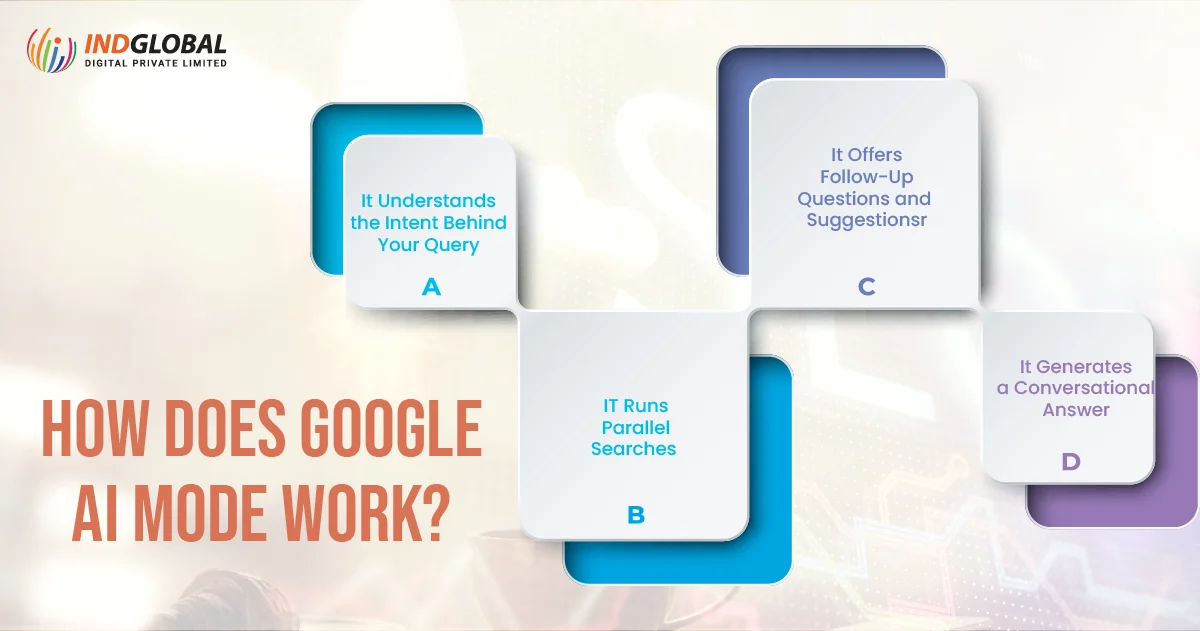Google is evolving too fast. In around three months, Google’s AI Mode went from an opt-in feature in Search Labs to a significant chapter of the Google Search experience. Now, users can have an end-to-end AI search experience.
But is this helpful for marketers or SEO specialists? Indeed, it is. Google’s AI Mode utilizes generative AI to enhance the delivery of search results, moving beyond simple keyword matching to a more intent-driven, conversational experience. This means traditional SEO strategies may not be enough going forward.
What Is Google AI Mode?
Google AI Mode is an end-to-end AI search experience similar to ChatGPT. It’s an upgraded model of traditional search. Earlier, it would only display a list of links. Still, now it utilizes advanced artificial intelligence to recognize your complete query, break it down into parts, and provide a direct, conversational answer directly on the results page.
It’s a perfect blend of a search engine and a clever assistant. Apart from just matching keywords, it is familiar with the context and needs of your query, pulls dependable information from across the internet, and additionally presents a quick and correct summary.
This mode is powered by Google’s Gemini AI model, enabling it to process and respond in natural language. Whether you’re asking a multi-step question, comparing options, or seeking deeper insights, AI Mode gives you a response that feels less like a search and more like a well-informed conversation.
How Does Google AI Mode Work?

Google AI Mode is designed to answer you, not just search for you. It’s fast, smart, and built to reduce friction in information discovery, reshaping the SEO game from ranking high to being worthy of being cited in AI-generated responses. It’s powered by advanced generative AI, for example, the Gemini 2.5 model. It does not just rely on the concept of showing a list of links based on keyword matching; instead, it takes a multi-step approach to understand and respond to all user queries. This is basically how it works:
1. It Understands the Intent Behind Your Query
AI mode doesn’t just focus on individual keywords. It gets your needs and context behind each prompt and even asks you counter-questions to get more clarification. For example, if you search “best laptops for students under 50k with good battery life,” the AI understands that you’re asking for:
- Best laptops
- Under ₹50,000
- With a strong battery life
Specifically for students
2. IT Runs Parallel Searches
Instead of performing a single linear search, AI Mode runs multiple searches simultaneously. It gathers content from reliable sources and synthesizes that information to provide a comprehensive summary, not just pulling text from one website, but generating a cohesive response based on multiple sources.
3. It Generates a Conversational Answer
The response is presented in a natural, easy-to-read format, almost like chatting with an expert. It includes:
- A summarized answer
- Links to cited sources
- Follow-up prompts, such as “Compare options” or “Show more details.”
4. It Offers Follow-Up Questions and Suggestions
After answering the initial query, AI Mode provides intelligent follow-up questions you might ask next. For example, after showing you the best laptops, it might ask, “Want to compare prices?” or “Looking for laptops for video editing?”
This keeps the user engaged in the search experience, making it feel more like a conversation than a traditional Google search.
Google AI Mode vs Traditional Search
| Feature/Aspect | Google AI Mode | Traditional Google Search |
| Search Output | Conversational summary with citations | List of blue links (webpages) |
| Technology | Powered by Generative AI (Gemini model) | Based on keyword matching and indexing |
| Query Understanding | Understands user intent and breaks queries into parts | Matches exact keywords and phrases |
| Result Format | AI-generated answers + follow-up prompts | Title, meta description, and page link |
| Click-Through Rates (CTR) | Lower CTR due to answers shown directly on the page | Higher CTR (users must click to access full content) |
| Source Attribution | Cited within AI summary (limited visibility) | Full visibility and traffic to ranking sites |
| Content Discovery | Focuses on authoritative, structured content | Focuses on backlink profile, keyword usage, page quality |
| User Engagement | Interactive (chat-style experience with follow-ups) | One-way (search, click, read) |
| SEO Focus | Generative Engine Optimization (GEO) / AEO | Traditional SEO: keywords, backlinks, rankings |
| Use Cases | Complex questions, comparisons, and summaries | Navigational, transactional, and informational searches |
| Search Evolution | Future-facing (2024–2026 rollout and beyond) | Current dominant format (but gradually declining) |
How Does AI Mode Impact SEO?

1. Drops in Organic Traffic
AI Mode answers user queries directly on the search page, so fewer users need to visit external websites to learn more about the topic. Even if your content is cited, it may not result in the same traffic volumes as before. This leads to a rise in zero-click searches, where Google provides the answer without the user having to leave the results page.
2. Rankings Are No Longer Everything
In traditional SEO, ranking #1 was the primary goal. But now, getting cited in AI responses matters more than a #1 ranking. The AI may pull content from a lower-ranked but more structured or trusted page.
3. Structured, Clear Content Wins
AI Mode favors content that’s well-organized and easy to understand. Formatting with clear headings, bullet points, FAQs, and short paragraphs helps AI extract and summarize information accurately. Poorly structured content is generally skipped, even if it’s informative.
4. Authority and Trust Are Crucial
AI Mode prioritizes content that comes from trusted and credible sources. It includes author expertise, site security, external references, and overall content quality. Without these signals, even relevant content may be ignored by the algorithm.
How Should SEOs Respond to AI Mode?

1. Focus on Answer-Ready Content
If you want to be featured in AI-generated summaries, your content should be designed to provide direct, informative answers. Your web or blog serves as a base, so write in a manner that AI can easily extract information from it; write in a way that clearly and concisely answers a consumer’s question.
Quick Actions:
- Start with a straightforward question or topic in the heading.
- Use simple, straightforward answers early in the content.
- Add FAQ sections and summaries.
- Focus on user intent, not just keywords.
2. Optimize for Generative Engine Optimization (GEO)
GEO is the next evolution of SEO. Instead of optimizing for ranking alone, you optimize your content to be used by AI in real-time search summaries. This means formatting, clarity, and trust are more important than ever.
Quick Actions:
- Use structured data (schemas) to signal content type.
- Incorporate headings, tables, and bullet points.
- Avoid fluff—be factual, direct, and well-organized.
- Think: “Is this answerable by AI?” before publishing.
3. Strengthen E-E-A-T Signals
Google’s AI looks for trust signals to decide which content is credible. You need to refine your website and content to effectively demonstrate your real experience, expertise, authority, and trustworthiness.
Quick Actions:
- Add detailed author bios with credentials.
- Cite sources and link to reputable sites.
- Use HTTPS and display contact info clearly.
- Keep your content updated and professionally written.
4. Track Visibility Beyond Rankings
Clicks and rankings can decline you so SEOs must start tracking brand mentions, citations in AI answers, and other non-traditional visibility metrics. SEO success now includes being part of the conversation, even if it’s not in the form of traffic.
Quick Actions:
- Monitor AI citations through tools and search Labs.
- Use Google Search Console for impressions & queries.
- Track engagement from zero-click searches.
- Measure awareness, not just conversions.
Optimizing Across Search Channels (i.e., OmniSEO™)

Within the age of Google AI Mode, visibility isn’t limited to just traditional search consequences. Users are seeking content across a wide variety of platforms, from AI-generated solutions and voice search to social snippets, YouTube videos, and even photo-based search. That’s where OmniSEO™ is available, a holistic, cross-channel method to SEO that ensures your content material performs across all discovery points, not just on Google’s first page.
OmniSEO™ specializes in making your brand searchable, discoverable, and cited across multiple surfaces. It’s not just about optimizing for text search; it’s about being everywhere users search.
1. Think Beyond Conventional Google Search
Optimize your content for AI Mode, YouTube search, Discover Feed, Voice Assistants, and image search. Each platform uses its own algorithm and content material signals.
Short actions:
- Repurpose blog posts into videos, reels, carousels, and infographics.
- Upload captions and transcripts to videos for YouTube SEO.
- Optimize visuals for Google Lens and image search.
- Post content material to Google News and Discover feeds.
2. Prepare for Voice & Conversational Search
With voice search and AI chat interfaces growing, your content must reflect natural language queries and conversational tone. AI assistants pull short, clear responses from structured content.
Short actions:
- Use long-tail, query-based keywords.
- Create voice-friendly content (simple language, quick answers).
- Build conversational FAQs.
3. Align SEO with Social Discovery
More users are coming across content material on platforms like Instagram, TikTok, and Pinterest, then heading to Google with more specific questions. These social signals can strengthen your visibility.
Short actions:
- Use trending hashtags and SEO-rich captions.
- Optimize profile bios and link trees for search relevance.
- Include consistent brand keywords across platforms.
- Interlink content between websites and social platforms.
4. Create Unified Search-Ready Content
The middle concept behind OmniSEO™ is content synergy. A single blog post can power your AI quote, video SEO, Pinterest graphic, and Instagram carousel if it’s designed to be repurposed efficiently.
Short actions:
- Design content to be modular and reusable.
- Plan content calendars around search intent across channels.
- Use UTM tracking to monitor visitors from non-Google sources.
- Maintain a consistent tone and branding across all formats.
Conclusion
Google’s AI Mode is not just a feature; it’s the future of how users search, discover, and engage with content. As AI takes center stage, basic SEO strategies alone are no longer sufficient. SEOs need to change their orientation from rankings alone to visibility across channels, credibility, and AI-friendliness if they want to remain visible and relevant.
Whether for AI summaries, voice search, or social discovery, the secret to success is producing high-quality, structured, and agile content that satisfies both human and machine needs. Adopting methodologies such as OmniSEO™ and Generative Engine Optimization (GEO) will position you ahead of the curve in a rapidly AI-centric search environment.
The rules are evolving, but so are the opportunities. Adapt early, and you won’t just survive the shift; you’ll lead it.
















